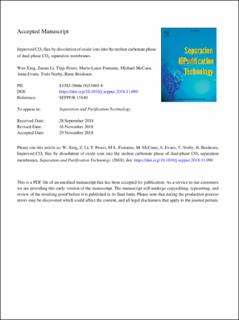| dc.contributor.author | Xing, Wen | |
| dc.contributor.author | Li, Zuoan | |
| dc.contributor.author | Peters, Thijs | |
| dc.contributor.author | Fontaine, Marie-Laure | |
| dc.contributor.author | McCann, Michael | |
| dc.contributor.author | Evans, Anna | |
| dc.contributor.author | Norby, Truls Eivind | |
| dc.contributor.author | Bredesen, Rune | |
| dc.date.accessioned | 2020-12-23T11:08:56Z | |
| dc.date.available | 2020-12-23T11:08:56Z | |
| dc.date.created | 2019-01-25T16:47:00Z | |
| dc.date.issued | 2019 | |
| dc.identifier.citation | Separation and Purification Technology. 2019, 212 723-727. | en_US |
| dc.identifier.issn | 1383-5866 | |
| dc.identifier.uri | https://hdl.handle.net/11250/2720921 | |
| dc.description.abstract | In a solid-liquid dual-phase CO2 separation membrane, the native ions in the molten alkali carbonate, including carbonate anions and metal cations can transport CO2 in a process that is charge-compensated by electronic species (electrons or holes), oxide ions, or hydroxide ions, depending on materials and conditions. This strongly affects the design of experiments for assessing the performance of these membranes, and further determines the routes for integration of these membranes in industrial applications. Here we report how dissolved oxides in the liquid carbonate improve the CO2 flux of the membrane due to an enhanced charge-compensating oxygen ion transport. A qualitative understanding of the magnitude and role of oxide ion conductivity in the molten phase and in the solid support as a function of the temperature is provided. Employing a solid matrix of ceria, and dissolving CsVO3 and MoO3 oxides in the molten carbonate phase led to an almost doubled CO2 flux at 550 °C under dry ambient conditions. When the sweep gas contained 2.5% H2O, the CO2 flux was increased further due to formation of hydroxide ions in the molten carbonate acting as charge compensating species. Also, as a consequence of permeation controlled by ions in the liquid phase, the CO2 flux increased with the pore volume of the solid matrix. | en_US |
| dc.language.iso | eng | en_US |
| dc.publisher | Elsevier | en_US |
| dc.rights | Attribution-NonCommercial-NoDerivatives 4.0 Internasjonal | * |
| dc.rights.uri | http://creativecommons.org/licenses/by-nc-nd/4.0/deed.no | * |
| dc.subject | Solubility of oxides | en_US |
| dc.subject | Molten carbonates | en_US |
| dc.subject | CO2 separation | en_US |
| dc.subject | Dual-phase membranes | en_US |
| dc.title | Improved CO2 flux by dissolution of oxide ions into the molten carbonate phase of dual-phase CO2 separation membranes | en_US |
| dc.type | Peer reviewed | en_US |
| dc.type | Journal article | en_US |
| dc.description.version | acceptedVersion | en_US |
| dc.rights.holder | This is the authors’ accepted and refereed manuscript to the article.This manuscript version is made available under the CC-BY-NC-ND 4.0 license. DOI: https://doi.org/10.1016/j.seppur.2018.11.090 | en_US |
| dc.source.pagenumber | 723-727 | en_US |
| dc.source.volume | 212 | en_US |
| dc.source.journal | Separation and Purification Technology | en_US |
| dc.identifier.doi | 10.1016/j.seppur.2018.11.090 | |
| dc.identifier.cristin | 1665340 | |
| dc.relation.project | Norges forskningsråd: 207841 | en_US |
| dc.relation.project | Norges forskningsråd: 272688 | en_US |
| cristin.unitcode | 7401,80,62,0 | |
| cristin.unitcode | 7401,80,40,0 | |
| cristin.unitname | Bærekraftig energiteknologi | |
| cristin.unitname | Prosessteknologi | |
| cristin.ispublished | true | |
| cristin.fulltext | postprint | |
| cristin.qualitycode | 1 | |

